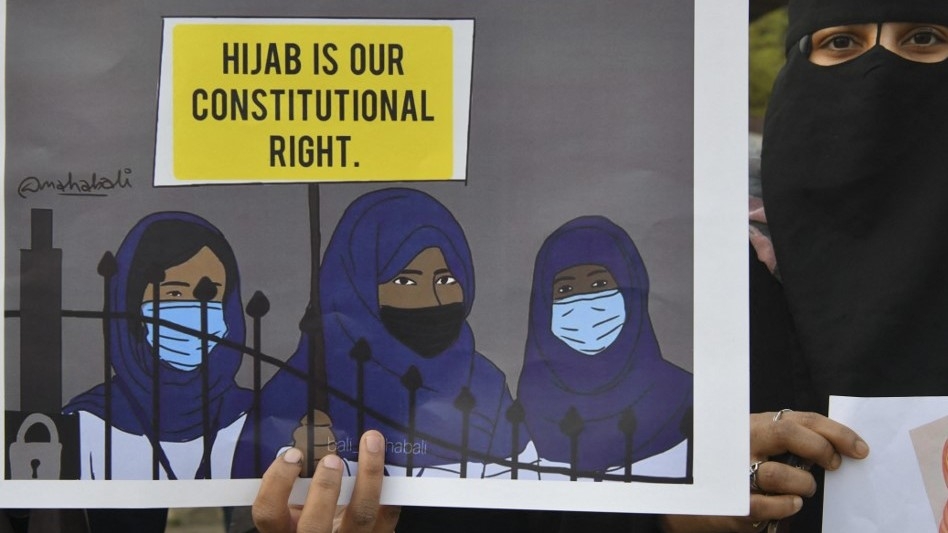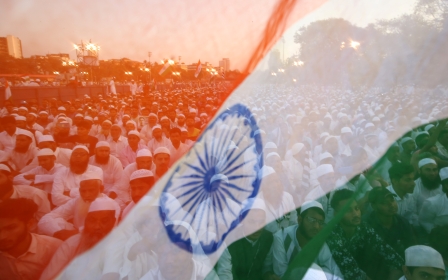India hijab ban: Why targeting of Muslim female students raises fear of new pogroms

Recent disturbing video footage showing female Muslim students in Karnataka state at their closed college gate, desperately pleading with their principal to let them enter campus, highlights the dangerous climate facing this politically besieged minority community in India.
The women were excluded from attending classes because they wear headscarves or face veils. With no support from the BJP government of Prime Minister Narendra Modi, the young women have turned to the media to make their case, hoping they will ultimately be able to take their exams and pursue future careers.
Their religious affiliation has become their primary identity, one used to excise them from the body politic like a virus
While there has been an upsurge in recent years of attacks and hate speech by members of India’s Hindu majority against non-Hindu communities, such violence is nothing new. Muslims are framed as a particular demographic and political threat to a Hindu rashtra (a Hindu religious supremacist state). Muslims in India have been threatened with massacres, attacked by mobs forcing them to chant Indian nationalist and Hindu religious slogans, brutally beaten and burned alive, and seen their mosques vandalised.
Until recently Muslim men have been the conventional focus of Indian Islamophobia, under the guise of the anti-terrorism police actions and so-called "love Jihad" witch hunts. But now Muslim women are increasingly under attack. Hindutva networks and their foot soldiers have posted faux-auctions online, purportedly selling Muslim women and using derogatory slurs.
To her dismay, journalist Ismat Ara discovered that the suspects in the networks were all young people, and one of them is an eighteen year-old female orphan. She wrote: “What better expresses the rot in Indian society today?"
'Why did you stay here?'
Young Hindu men and women have taken to wearing saffron scarves on campus in protest against the hijab, turning it into a tit-for-tat and claiming that Hindu rights are violated by Muslim women wearing Islamic attire. For Hindu youth, the saffron scarves seem to be deployed against Muslim women’s headscarves, to establish Hindu dominance. But Muslims are already a minority: Hindus are 79.8 percent of India’s population, while Muslims are 14.2 percent.
Muslim students, meanwhile, worry about the impact a prolonged row could have on their grades, and are stunned at how the attacks on their religious identity have escalated.
Some college authorities have said they were operating under government orders, while officials have also claimed baselessly that the hijab violates college uniform regulations. Frenzied commenters have flooded social media, suggesting that if the hijab and burqa were permitted in educational institutions, Indian Muslims would then impose “sharia law” on the country.
Mob hysteria, fostered by the country’s political leaders, has spread from Karnataka to other states. The education minister in Madhya Pradesh recently said the hijab would be banned in schools in that state. Some college professors demanded that Muslim students quit greeting each other with the Islamic greeting (salam) and even quit speaking in Urdu, the language of Indian Muslims.
A Hindu member of parliament, Pratap Simha, suggested that Muslims who wear distinctive religious clothing should attend Islamic madrassas, adding that India was a Hindu country where Islam did not belong: “If you still insist on practising sharia, we have already given you a separate country in 1947… So why did you stay here?”
For Indian Muslims, “Go to Pakistan” is not a new taunt, nor is it harmless teasing. It is reminiscent of the 2002 pogrom in Gujarat.
Forced into a corner
Battle lines have been drawn in educational institutions overnight, forcing Muslim women into a corner. Their religious affiliation has become their primary identity, one used to excise them from the body politic like a virus. One Karnataka official instructed women wearing the hijab to quit attending college, as they had "polluted the atmosphere of the college".
As with most political and ideological conflicts, women’s bodies end up serving as the battleground. Muslim women’s clothing is now either a virus to be removed or a cause to be championed; it is both fetishised and demonised.
As one 19-year-old student wrote: “I had read on social media the discrimination that Muslims in the country face but now I have experienced it for the first time. I was made to realise that I am a Muslim. Someone who dresses differently. I have never thought about these things before.”
Hindu extremists have used the hijab issue to paint Muslims as trouble-making outsiders. On social media platforms, spokespeople for Hindu extremist organisations have derided hijab as oppressive, pitting Muslim women’s hijab against Hindu men’s saffron scarves in a false equivalency.
This week, video emerged of a lone Muslim woman in Islamic dress going to college while being pursued by a crowd of young Hindu men wearing saffron scarves and chanting menacingly towards her. Rather than flee, she chanted “Allahu akbar” (God is great). She has been admired for her courage in standing her ground. Today, this is how she is known to strangers – as a warrior for hijab.
Indian Muslims are cornered into an isolationist Islamic identity, deprived of a shared national and community identity, even deprived of an education.
For the most part, however, concern for India’s Muslim women has been limited to fellow Muslim communities. One inevitably wonders about western human rights and women’s activists who admire the beloved Malala Yousafzai; their silence suggests that their concern does not extend to the educational futures of Indian Muslim women.
Succour seems to be offered to Muslim women only when Muslim men are the oppressors, and only as long as Muslim women dissociate from Islamic practices and Muslim communities.
The views expressed in this article belong to the author and do not necessarily reflect the editorial policy of Middle East Eye.
This article is available in French on Middle East Eye French edition.
Middle East Eye propose une couverture et une analyse indépendantes et incomparables du Moyen-Orient, de l’Afrique du Nord et d’autres régions du monde. Pour en savoir plus sur la reprise de ce contenu et les frais qui s’appliquent, veuillez remplir ce formulaire [en anglais]. Pour en savoir plus sur MEE, cliquez ici [en anglais].







